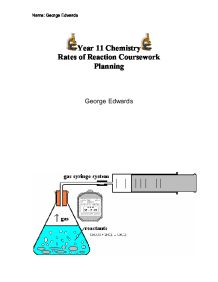I predict the higher the concentration of hydrochloric acid faster the reaction rate and more carbon dioxide will be produced as the time increases.
Marble chips and hydrochloric acid.
Marble chips are mostly made up of calcium carbonate which is a alkaline compound.
An investigation into how changing one variable influences the rate of reaction between marble chips and dilute hydrochloric acid planning section when dilute hydrochloric acid reacts with marble chips the following reactions occurs.
Caco3 2hcl h2o co2 this is the reaction we will be investigating.
The variables that i shall be changing will be the concentration of hydrochloric acid and water.
Finding the rate of reaction of marble chips and hydrochloric acid changing the surface area.
This is due to the collision theory.
In the investigation i am going to find out how the surface area affects the rate of reaction by measuring the amount of gas produced and weight loss in a reaction between small large pieces of marble chips calcium carbonate and hydrochloric acid per minute.
There are many variables that affect.
Marble chips react with dilute hydrochloric acid to produce carbon dioxide gas.
The rate of this reaction can be changed by changing the size of the marble chips.
A stand to hold up the measuring cylinder.
Finding the rate of reaction of marble chips and hydrochloric acid changing the surface area.
Marble chips and hydrochloric acid planning aim to find if changing the concentration of an acid will increase or decrease the rate of the reaction when marble is dissolved in hydrochloric acid.
A conical flask contains the marble chips hydrochloric acid and the water that will make the reaction.
Being alkaline it reacts with hydrochloric acid to produce calcium chloride water and carbon dioxide.
With the equation caco3 2hcl cacl2 h2o co2 hypotheses a reaction occurs when particles collide.
A tube to connect the conical flask to the measuring cylinder.
In high concentrated acid the particles of the marble chip will move faster due to the more collisions between the particles of marble chips and the acid.
Investigating the rate of reaction between marble chips calcium carbonate and hydrochloric acid aim.







